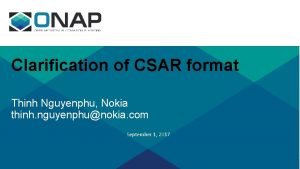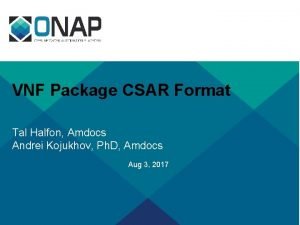Simple TOSCA Processor Service Inputs TOSCA CSAR TOSCA



- Slides: 3

Simple TOSCA Processor Service Inputs TOSCA CSAR TOSCA Processor Unpack Parse Validate Compiled Service Template Instantiate Service Instance Model External Orchestrator – Compiled Service Template (aka Semantic Template) • TOSCA Service Template that has been extracted from its CSAR package, parsed, validated, and converted to an internal TOSCA processor format. This internal format is implementation-specific and not standardized. – Service Instance Model: • An internal representation created by the TOSCA processor of a deployed service. The instance model format is implementation-specific and not standardized. – Instantiation: • The process of creating a Service Instance Model from a Compiled Service Template by providing user input values for the inputs defined in the Service Template. 1

Simple TOSCA Processor with Instance Model Build-Out Service Inputs TOSCA Processor TOSCA CSAR Fulfill Requirements Unpack Parse Validate Compiled Service Compiled Template Service Template Instantiate Service Instance Model Instantiate Substitute External Orchestrator – Instance Model Build-Out • • Fulfill mandatory dangling requirements Substitute nodes marked for substitution 2

Instance Model Build-Out Requirement fulfillment – Fulfill mandatory dangling requirements for all node instances in the instance model • • • By selecting existing node instances that have the “required” capabilities, and … Have the “required” target node type, and … Match the node filter if specified – Since the “Simple TOSCA Processor” does not use an inventory, dangling requirements can only be fulfilled by nodes in the Service Instance Model for the service that is being orchestrated. Substitution – Decompose abstract nodes (i. e. nodes marked for substitution using the ‘substitute’ directive) in the service instance model by substituting them with different service instance models created from substituting templates. – Since the “Simple TOSCA Processor” does not use a catalog, substituting templates can only be found in the CSAR(s) used for the service that is being orchestrated. Copyright © 2020 Ubicity Corp. 3





